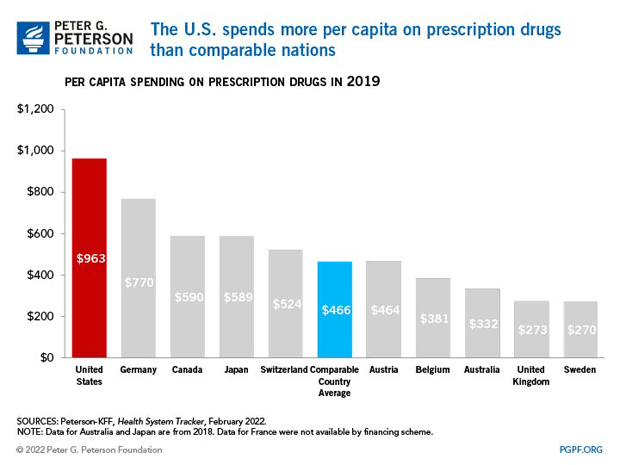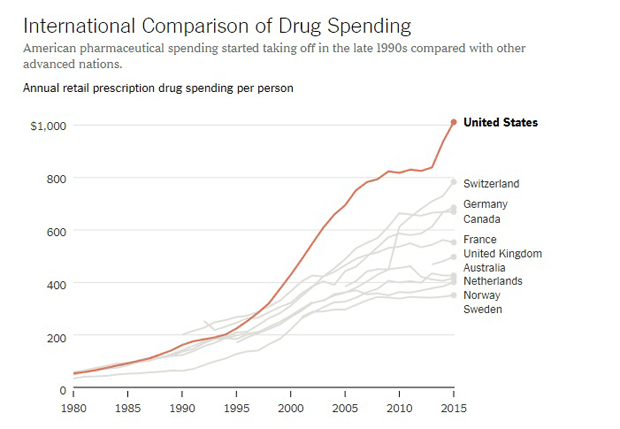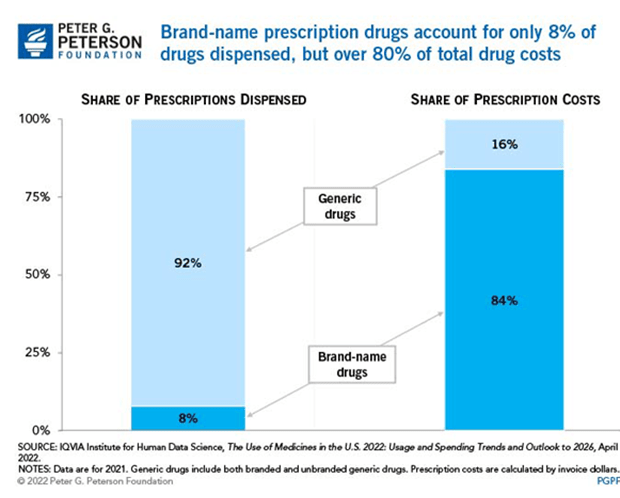Table of Contents
I. An Overview of Drug Prices in the U.S. vs. Other Countries
II. Why Are U.S. Drug Prices So High? 5 Factors that Contribute
IV. A More Affordable Alternative
Why are drug prices so high in the U.S.? It’s a point of concern and debate for many, especially regulatory bodies overseeing the development, approval, and sales of prescription drugs as well as the consumers who need them.
Filling an expensive prescription can be a financial hardship [1] for anyone. But for those who have serious or chronic conditions that require multiple medications and/or ongoing treatment, it can feel impossible to afford. An alarming 37% of Americans [2] report that they’ve even skipped a prescription altogether due to its cost.
And while the average U.S. resident won’t be able to change the problem overnight, many want to understand why it’s happening and what they can expect in the future.
In this article, we’ll break down the factors contributing to the exorbitant drug prices in the U.S. and consider the situation from different perspectives—that of the drug developers and manufacturers, government leaders and organizations, healthcare and insurance companies, and of course U.S. consumers.
Quick Takeaways
- Prescription drug prices in the United States are 240% higher than the combined average for comparable countries.
- The large disparity between U.S. drug prices and those in other countries began in the late 1990s thanks to drivers like lax price regulation, direct-to-consumer and -physician advertising, and patent protection laws.
- Today, these drivers continue to keep U.S. drug prices higher than the rest of the world.
- Online Canadian pharmacies offer a more affordable alternative to U.S. residents who need prescription drugs.
An Overview of Drug Prices in the U.S. vs. Other Countries
Drug prices in the United States are more expensive than other countries across the board.
When considered collectively, brand name drug prices in the U.S. are 240% higher [3] than other countries (averaged together), and 70% higher than the country with the next-highest prices—Mexico. Per capita, the U.S. spends $963, vs. the comparable country average of $465.
But this large disparity didn’t always exist. In fact, up until the late 1990s, prescription drug spending per capita in the U.S. was similar to other comparable nations. Then, between 1997 and 2007, it tripled. What happened to cause this huge jump? The New York Times recently summed up [4] a perfect storm of factors that combined to cause U.S. drug prices to skyrocket above those of other countries and stay there. Their research found that some of the factors often assumed responsible for the price disparity—things like overuse of prescription drugs in the U.S. or lack of generic drugs—weren’t actually even true at all. Instead, it’s a lack of regulation around drug prices, patent and market exclusivity timeframes, and the drug advertisement and promotion culture that’s unique to the United States but such a central part of how drugs are marketed and sold there. In the late 1990s specifically, an explosion of new “Blockbuster” drugs on the market pushed U.S. prices way higher than the rest of the world to create a separation that never really closed again, even after FDA approvals for these drugs slowed around 2007. To truly understand these main drivers of high U.S. drug prices, let’s dive into each in more detail and explore how it still impacts the U.S. prescription drug market in 2023. Brand-name drugs are 4.9X higher [5] in the United States than other countries, largely due to the combination of patent protection and lax price regulation (both of which we’ll cover next). As a result, brand name drugs now account for only 8% of drugs dispensed in the U.S., but 80% of the prescription drug spending. Patent protection laws in the United States typically give pharmaceutical companies exclusive rights to manufacture and sell medications for 20 years after they’re developed. This means the generic versions take longer to become available and may be less available even once they are approved. This cycle keeps higher-priced brand-name drugs driving costs up. The absence of direct price regulation is a significant contributor to high drug prices in the U.S. Unlike many other developed countries, the U.S. government does not have the authority to negotiate prices directly with pharmaceutical companies for federal health insurance programs. This lack of negotiation power allows pharmaceutical companies to set their own (typically higher) prescription drug prices. Pharmaceutical companies in the U.S. allocate substantial resources to advertising medications to both physicians and consumers. The direct-to-consumer advertising permitted in the United States means companies can market products directly to patients via various media channels. These marketing efforts, including television commercials and print advertisements, drive up drug prices as companies aim to recoup their advertising expenses At the same time, pharmaceutical companies engage in targeted marketing strategies aimed at healthcare providers, influencing prescribing practices and potentially leading to the wider use of higher-cost medications. The complex distribution and rebate systems within the U.S. healthcare system also contribute to its higher drug prices. Pharmaceutical manufacturers negotiate rebates and discounts with pharmacy benefit managers (PBMs) and insurance companies, but the lack of transparency in these arrangements makes it challenging for consumers to understand the true cost of their medications. The complex nature of distribution and rebates creates a convoluted system of list prices, net prices, and undisclosed rebates, making it difficult for patients to effectively compare prices and navigate the pharmaceutical market for cost savings. So—why are drug prices so high in the U.S.? As you can tell, it’s due to a myriad of factors that are complex and interwoven. While government action to alleviate high drug costs has increased during both the Trump and Biden administrations, the issue won’t be solved overnight. For now, thanks to lax price regulations, longstanding patent protection laws, and the ability for pharmaceutical companies to advertise to consumers and physicians, prescription drug prices in the United States will likely remain high for the foreseeable future. Americans in need of prescription drugs are increasingly turning to online Canadian pharmacies to purchase the medications they need at a lower cost from a trusted, reputable source. My Drug Center is a CIPA-certified Canadian pharmacy that helps thousands of Americans save on their prescriptions every year. We’re committed to fast delivery and unbeatable prices so you never have to stress about having the medication you need. Learn more about how to order and save up to 80% on your medications today.

Why Are U.S. Drug Prices So High? 5 Factors that Contribute
Spending on Brand-Name Drugs

Patent Protection and Market Exclusivity
Lack of Price Regulation
Advertising to Physicians and Consumers
Complex Distribution and Rebates
Final Thoughts
A More Affordable Alternative
